|
I never really warmed up to the Ruger Redhawk.
Donít get me wrong; it is an excellent revolver. Since its
introduction in 1979, it has proven to be a rugged, reliable,
accurate, and very strong sixgun. I have just always preferred
single action revolvers for my own use, and found the Redhawks
to be a bit larger and heavier than what I preferred to carry.
They have been offered chambered for a variety of heavy-duty
cartridges, and with barrel lengths of five and one-half or seven and
one-half inches. I also never really found the standard grip on
the Redhawk to fit my hand, so I just never got really excited
about the gun. It remained that way until I heard of Rugerís
intention to introduce the Redhawk with a four inch barrel, and
suddenly the gun is not much bigger than a Smith
& Wesson Mountain Gun, although it is still heavier
at 46.6 ounces, unloaded. However, it is also a lot
stronger than the Mountain Gun, has a much heavier frame, and
has very thick chamber walls. This makes the Redhawk the
strongest double-action .44 Magnum available, and the four inch
barrel suddenly makes the Redhawk comfortably packable in a
well-designed holster. I decided to try it out, and placed my
name on the list to review the new sixgun as soon as production
was underway.
I have only had the new Redhawk here for a few
weeks now, but so far, I am impressed. Not only have the
handling qualities of the Redhawk improved by the use of the
shorter barrel, but it seems that Rugerís quality is starting
to improve dramatically as well. At first, I thought that I just
got a fluke, but after speaking with other shooters who have
received a new Redhawk, they confirmed that the sixgun is much
smoother in action that previous Redhawks that they had known.
Now, I never thought that I would be making this statement, but
this Ruger has the smoothest double-action trigger pull that I
have felt on a new revolver in a long time. Ruger has made some
changes at the factory, and it looks as if they have paid off.
The double-action trigger pull measures just over eight and
one-half pounds, but its smoothness makes it feel much lighter.
The single action pull measured a bit heavier than I like at
seven pounds, two ounces, but it is crisp and clean, and easily
lightened if desired.
The new Redhawk wears seamless finger groove Hogue
synthetic rubber grips. There are no screws holding the grip to
the frame, and to remove the grip, a plastic wedge is provided
to help in the removal. The dern thing is plenty tight, and it
is a bit aggravating to remove, but it is something that is
seldom needed, and is easier once the technique is learned. The
grip feels good to my hand, and the pebble finish helps to keep
a good firm grasp on the weapon under recoil.
Recoil is not bad at all with normal weight .44
magnum loads, but with the heavy weight bullets at top speeds,
the hand can take a beating after a shooting session with a box
of those loads. The backstrap is not covered, which helps with
trigger reach and control, but the steel frame contacts the web
between the thumb and forefinger. After a while, it can become
unpleasant, but again, with normal magnum loads, it is not a
problem, and a glove helps tremendously with the heavy stuff.
Like all Redhawks, the sixgun is built for years
of hard use. A shooter does not buy a Redhawk with expectations
of having to have it rebuilt as it wears after a couple of
thousand magnum loads. You will not wear out a Redhawk by
shooting it. The design is a solid frame, with no side plate,
and the massive cylinder locks up in front at the crane and at
the rear into the recoil plate of the heavy frame. The ejector
rod does not rotate, and will never unscrew itself from its
fixed position, locking up the cylinder, as happens too
frequently with some other double-action revolvers. The cylinder
bolt notches are cut a bit off center, making a stronger
cylinder wall than on designs that place the cut directly over
the center of each chamber. The barrel/cylinder gap measured
just three one-thousandths of an inch (.003") on the test
gun, which I was glad to see.
The Redhawk wears a good set of fully adjustable
blued steel sights, and the front ramp has a red insert to help
the sight picture in certain lighting conditions, as well as a
white outline rear notch. The hammer spur is checkered for
a secure hold while cocking the piece for single action fire,
and the firing pin is protected from accidental discharge by
Rugerís famous and proven transfer bar safety system.
Thankfully, there is no key lock on the Redhawk design, at least
not yet.
While the handiest Redhawk yet, the sixgun is
still by no means a pocket gun, but a good holster makes the gun
ride comfortably on the hip or across the chest, depending upon
the mission at hand. One of the best and most versatile
holsters available for the Redhawk, or any other large revolver,
is the Simply Rugged Pancake style as built by Rob
Leahy of Wasilla, Alaska. Rob knows how to build a holster.
The one pictured here offers great protection to the sidearm,
and allows for either strong side or cross draw carry. I carried
the four inch Redhawk comfortably in this holster. It works very
well for concealment of a big revolver under a shirt or light
jacket, and doubles as a very versatile field holster. He can
build them with or without the thumb break protecting the
hammer, builds them out of top grade materials, and his work
exhibits excellent craftsmanship. His prices are downright cheap
for the quality of his holsters. I have a few of them, and they
all receive their share of time on my hip.
Firing the four inch Redhawk resulted in perfect
function. I was a bit concerned that the light double-action
trigger pull might fail to ignite a primer with light strikes,
but these concerns were unfounded. The Redhawk never failed,
firing reliably in both double- action and single-action modes.
Chronograph data was obtained on a sunny but cool day,
with a temperature varying from twenty-three to thirty-seven
degrees Fahrenheit. The results are listed below:
.44 Magnum Loads
| Manufacturer |
Bullet Style |
Bullet Weight |
Velocity |
| Handload |
LFP |
200 |
1043 |
| Cor-Bon |
JHP |
180 |
1613 |
| Cor-Bon |
BCHP |
260 |
1365 |
| Cor-Bon |
LHC |
320 |
1197 |
| Grizzly |
WFNGC |
300 |
1122 |
| Grizzly |
Hawk SP |
250 |
1247 |
| Grizzly |
Hawk SP |
275 |
1129 |
| Grizzly |
WLNGC |
320 |
1100 |
| Bruin |
LFN |
295 |
1228 |
| Bruin |
Keith |
250 |
1326 |
| Remington-UMC |
JHP |
180 |
1498 |
.44 Special Loads
| Speer |
GDHP |
200 |
807.7 |
| Federal |
SWHP |
200 |
841.7 |
| Cor-Bon |
JHP |
165 |
1178 |
All velocities are listed in
feet-per-second (fps). Bullet weights are listed in grains. JHP
is jacketed hollowpoint. BCHP is bonded core hollowpoint. HC is
hard-cast lead. GDHP is Gold Dot Hollowpoint. WFNGC is a wide
flat nose gas check lead bullet, and WLNGC is a wide long nose
gas check bullet, both made by Cast
Performance Bullet Company. LFN is lead flat nose. SP is
soft point jacketed. Keith is the famous semi-wadcutter design
by Elmer Keith. Velocities were measured at a distance of
twelve feet with a PACT chronograph.
Accuracy was tested using the Ransom
Master Series Machine Rest. This rest makes it possible
to remove all human influence upon the accuracy of the revolver,
eliminating factors such as shooter fatigue and trigger control
upon the revolverís accuracy. On a real good day, I can hold a
sixgun over a solid rest and shoot about as accurately as I can
with a machine rest, but I donít have as many good days as I
once did. With the Ransom, I can shoot all day long, and know
that the gun is getting a fair shake, without my abilities or
lack thereof influencing the results. The Ransom is also
an excellent way to determine which particular loads will shoot
well in any given handgun, without the influence of the shooter
skewing the results. I tried the Redhawk with fourteen different
loads, both magnum and Specials, and also with my one lead
plinking handload. I did not try to work up a target load for
the Redhawk, preferring to use ammunition that I believe will be
the most useful in this type of handgun; .44 Specials for social
work, and Magnums for hunting and protection from large
carnivores. With most loads tested, the Redhawk grouped around
two and one-half inches at twenty-five yards for five shots.
Several of the loads tested did better, and a couple of them
turned in superbly accurate groups. The Grizzly Cartridge
320 grain WLNGC load grouped just slightly over one inch, and
the Bruin Cartridge 295 grain load grouped slightly less
than one inch. That is darn good accuracy with high performance
ammunition.
The four inch Ruger Redhawk is a dandy handgun.
It is relatively compact and reasonably light for the power it
packs. It excels as a trail companion when in areas that one
might encounter dangerous wild animals, and is compact enough to
serve as a good carry weapon for self defense against predators
of the human type. It is also a good revolver for hunting,
wearing a barrel that is long enough to be legal in most places,
and still handy enough for comfortable packing in a holster. I
like it better than the Alaskan
series of revolvers, especially in .44 magnum. I like the bit
extra barrel length, and the more compact and aesthetically
pleasing, at least to my eyes, frame of this Redhawk. I think
that this is the best Redhawk yet.
Check out the full line of Ruger products
here.
For the location of a Ruger dealer near you,
click on the DEALER LOCATOR icon at: www.lipseys.com.
To order any of the high performance ammunition
shown here, go to: www.cor-bon.com,
www.grizzlycartridge.com,
or www.bruincartridge.com.
To order a Simply Rugged holster, go to:
www.simplyrugged.com.
Jeff Quinn
|
To locate a dealer where you can
buy this gun, Click on the DEALER FINDER icon at: |
|

|
  
Got something to say about this article? Want to agree (or
disagree) with it? Click the following link to go to the GUNBlast Feedback Page.
|
|
Click pictures for a larger version.
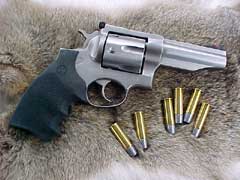
Ruger four-inch .44 Magnum stainless Redhawk.
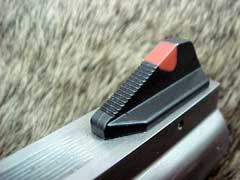

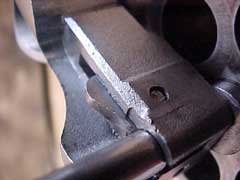
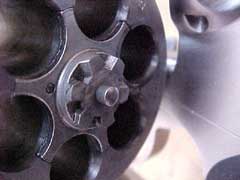
The super-strong Redhawk design locks the cylinder into
the frame at front and rear.
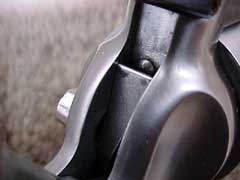
The Redhawk features Ruger's patented transfer-bar
safety system.
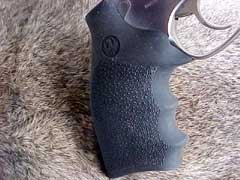
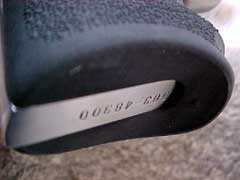
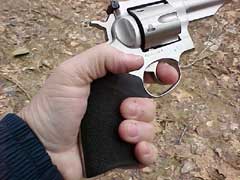
The new Redhawk comes with one-piece Hogue grips.
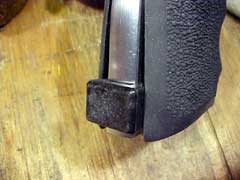
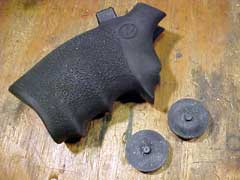
One-piece Hogue grips are removed by use of a special
wedge tool.
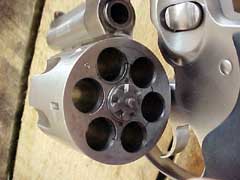
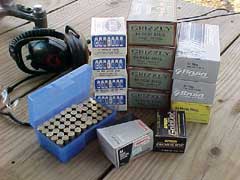
Jeff tested the Redhawk using a variety of .44 Magnum
and .44 Special ammunition.
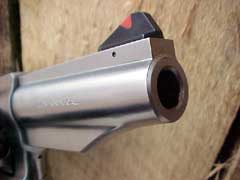
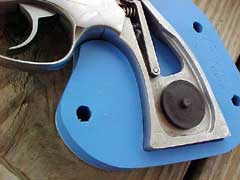
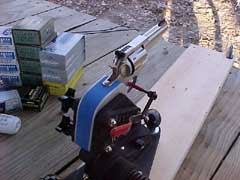
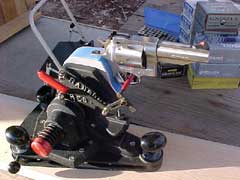
Jeff also used a Ransom Rest to take the guesswork out
of accuracy testing.

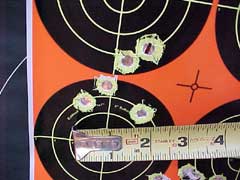
The Redhawk proved to be very accurate, turning in
groups such as this 2" group using Grizzly Cartridge
Company's 275-grain Hawk bullet load...
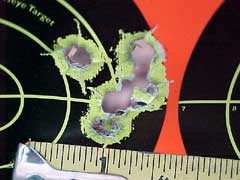
...and this 15/16" group using Bruin's 295-grain
LFN load.

The Redhawk was filthy at the end of a day's testing,
but function was perfect.

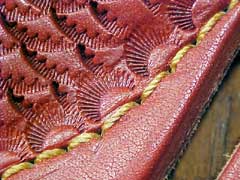
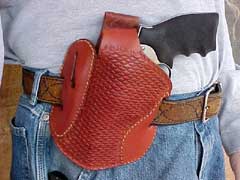
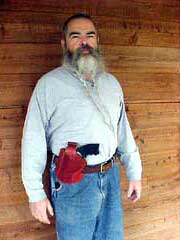
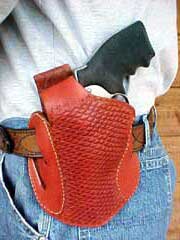
Rob Leahy's Simply Rugged Pancake Holster is a great rig
for field or concealed carry.
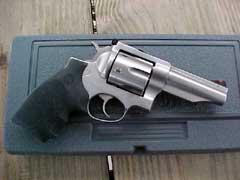
Although Jeff has never been a big fan of the Redhawk,
this new model has made a believer out of him!
|
![]()